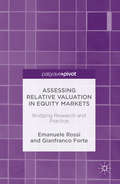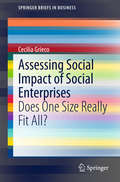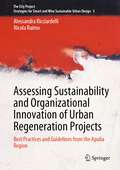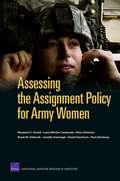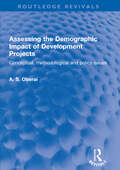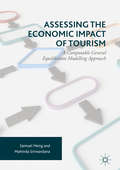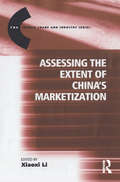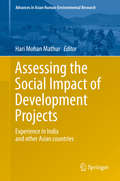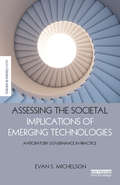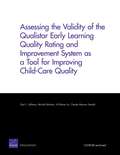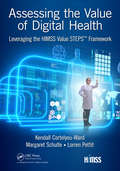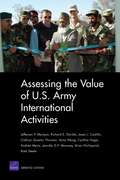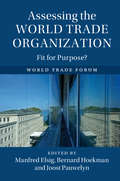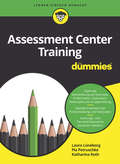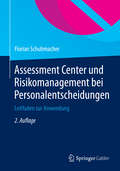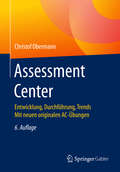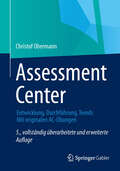- Table View
- List View
Assessing Relative Valuation in Equity Markets: Bridging Research and Practice
by Emanuele Rossi Gianfranco ForteThisbook addresses the gap between the widespread use of stock market multiples invaluation practice and the frontiers of research on multiples. The book's approachis twofold: the authors first analyse the performance of multiples metrics inpredicting the market price of a set of liquid and highly traded US stocks. Theauthors then employ these results to test profitable stock purchasingstrategies employed in order to 'beat the market'. The results presented widenour understanding of the "market performances" of the valuation tools practitionersutilise in their everyday work. The evidence is of interest to researchers and equity analysts, who wish to analyse the circumstances in whichvaluation errors using multiples are more frequent and when market multiplesbecome ineffective in estimating market prices.
Assessing Reserve Adequacy in Low-Income Countries
by Era Dabla-Norris Kazuko Shirono George Tsibouris Valerio Crispolti Kim Jun IlA report from the International Monetary Fund.
Assessing Social Impact of Social Enterprises: Does One Size Really Fit All? (SpringerBriefs in Business #0)
by Cecilia GriecoThis book explores the diversity of Social Impact Assessment (SIA) models and outlines a self-assessment on models to support social entrepreneurs. The chapters trace the concept and origins of social entrepreneurship and elicits current implementation of SIA models by social enterprises. The comprehensive review of over seventy five SIA models will be especially useful for social entrepreneurs and researchers.
Assessing Sustainability and Organizational Innovation of Urban Regeneration Projects: Best Practices and Guidelines from the Apulia Region (The City Project #3)
by Alessandra Ricciardelli Nicola RaimoThis book offers the first comprehensive report on the topic of organizational innovation and sustainability of urban regeneration from the public manager's perspective. Starting from a rich set of case studies on urban regeneration from the region of Apulia, in Italy, it develops a framework for measuring their sustainability performance. It proposes the use of indicators related to different aspects of the urban regeneration process, including the participations of stakeholders; land use and buildings; economy and jobs; transportation; environmental pollution; energy use; waste management; as well as open spaces and wildlife. This book offers extensive information to graduate students and researchers, and to authorities, developers, investors and stakeholders alike, involved in the design, planning and management, and sustainable development of urban spaces. It is expected to foster a better understanding of the level of organizational innovation and sustainability of urban regeneration projects and the role of governing bodies in their implementation.
Assessing World Bank Support for Trade, 1987-2004
by Yvonne Manu Tsikata Yvonne ManuAn independent evaluation of the World Bank's extensive support to developing countries on trade issues between 1987 and 2004. The study assesses the development effectiveness of World Bank trade-related advocacy, capacity-building, lending and research. It examines the extent to which the Bank's policies and assistance have met its stated objectives in the area of trade and makes recommendations to strengthen the effectiveness of future Bank trade assistance.
Assessing a Company's Future Financial Health
by Thomas R. PiperThe case provides students with (1) an understanding of the essence of long-term financial health; (2) familiarity with the calculation and meaning of various financial ratios; and (3) an understanding of the influence of a company's operating and competitive characteristics on its investment in various type assets, on the profitability of these investments, and on the financial structure of its balance sheet. The case also allows a discussion of (1) the incomplete and lagging nature of financial measures; (2) the influence of financial measures on behavior; and (3) the reality that financial analysis often results in better, more focused questions to be asked of management, not conclusive answers.
Assessing a Strategy's Fit with a Pattern: Pattern-Based Analysis of Disruptive Ideas
by Scott D. Anthony Mark W. Johnson Joseph V. Sinfield Elizabeth J. AltmanSuccessfully creating new growth innovations requires becoming an expert at recognizing and using patterns to assess and shape ideas. This chapter explains in detail how to assess the degree to which a strategy matches a pattern common to successful innovations.
Assessing and Improving Data Quality
by Thomas C. RedmanOrganizations with the best data invest their data quality efforts toward preventing errors at their sources. This chapter examines the cases of Tele-Tech Services, Interactive Data, and Morningstar, outlining ten data quality habits that organizations should adopt, and providing tools and role models that will enable managers to baseline their organization's current data quality efforts.
Assessing and Insuring Cybersecurity Risk
by Ravi DasRemote workforces using VPNs, cloud-based infrastructure and critical systems, and a proliferation in phishing attacks and fraudulent websites are all raising the level of risk for every company. It all comes down to just one thing that is at stake: how to gauge a company’s level of cyber risk and the tolerance level for this risk. Loosely put, this translates to how much uncertainty an organization can tolerate before it starts to negatively affect mission critical flows and business processes. Trying to gauge this can be a huge and nebulous task for any IT security team to accomplish. Making this task so difficult are the many frameworks and models that can be utilized. It is very confusing to know which one to utilize in order to achieve a high level of security. Complicating this situation further is that both quantitative and qualitative variables must be considered and deployed into a cyber risk model. Assessing and Insuring Cybersecurity Risk provides an insight into how to gauge an organization’s particular level of cyber risk, and what would be deemed appropriate for the organization’s risk tolerance. In addition to computing the level of cyber risk, an IT security team has to determine the appropriate controls that are needed to mitigate cyber risk. Also to be considered are the standards and best practices that the IT security team has to implement for complying with such regulations and mandates as CCPA, GDPR, and the HIPAA. To help a security team to comprehensively assess an organization’s cyber risk level and how to insure against it, the book covers: The mechanics of cyber risk Risk controls that need to be put into place The issues and benefits of cybersecurity risk insurance policies GDPR, CCPA, and the the CMMC Gauging how much cyber risk and uncertainty an organization can tolerate is a complex and complicated task, and this book helps to make it more understandable and manageable.
Assessing and Managing Security Risk in IT Systems: A Structured Methodology
by John McCumberThis book begins with an overview of information systems security, offering the basic underpinnings of information security and concluding with an analysis of risk management. Part II describes the McCumber Cube, providing the original paper from 1991 and detailing ways to accurately map information flow in computer and telecom systems. It also explains how to apply the methodology to individual system components and subsystems. Part III serves as a resource for analysts and security practitioners who want access to more detailed information on technical vulnerabilities and risk assessment analytics. McCumber details how information extracted from this resource can be applied to his assessment processes.
Assessing the Assignment Policy for Army Women
by Margaret C. Harrell Jennifer Erin Kavanagh Bryan W. Hallmark Peter Schirmer Laura WerberSince current policies for assigning military women were issued, the U.S. Army has changed how it organizes and fights. Assessing the Assignment Policy for Army Women considers whether the Army is adhering to the assignment policies as well as the appropriateness of the current U.S. Department of Defense and Army assignment policies, given how units are operating in Iraq.
Assessing the Demographic Impact of Development Projects: Conceptual, methodological and policy issues (Routledge Revivals)
by A. S. OberaiFirst published in 1992, Assessing the Demographic Impact of Development Projects based on studies in developing countries focuses on conceptual, methodological and policy issues related to development projects. It considers whether demographic effects can be assessed and why development planners should be interested in such an assessment. A.S. Oberai examines the extent to which economic and social changes generated by specific development interventions have influenced demographic behaviour in a particular context. He suggests how desired effects can be enhanced and undesired effects minimized by policy makers and planners in developing countries in order to deal with problems of population growth and its distribution. The major shortcomings of existing methodologies are identified, and the author indicates the future direction which research might take in order to be more scientifically valid and useful to policy makers. This book is a must read for scholars and researchers of development studies, political economy and labour economy.
Assessing the Economic Impact of Tourism: A Computable General Equilibrium Modelling Approach
by Samuel Meng Mahinda SiriwardanaThis book employs a computable general equilibrium (CGE) model - a widely used economic model which uses actual data to provide economic analysis and policy assessment - and applies it to economic data on Singapore's tourism industry. The authors set out to demonstrate how a novice modeller can acquire the necessary skills and knowledge to successfully apply general equilibrium models to tourism studies. The chapters explain how to build a computable general equilibrium model for tourism, how to conduct simulation and, most importantly, how to analyse modelling results. This applied study acts as a modelling book at both introductory and intermediate levels, specifically targeting students and researchers who are interested in and wish to learn computable general equilibrium modelling. The authors offer insightful analysis of Singapore's tourism industry and provide both students and researchers with a guide on how to apply general equilibrium models to actual economic data and draw accurate conclusions.
Assessing the Extent of China's Marketization (The Chinese Trade and Industry Series)
by Xiaoxi LiChina is indisputably one of the most dynamic economic regions in the world; however the character, nature and extent of its market economy status remains in question. This book provides an empirical analysis of many aspects of the developing market economy including: government reform; the marketization of enterprises; land transactions; capital transactions and finance; the market determination of wage rates; the development of intermediary organizations; and the improvement in the economy's legal framework. China's economic growth has also brought conflict with both the EU and the US. This book examines the contentious debates such as: the extent of renminbi convertibility; the independence of the financial sector; the freedom of labour in wage-rate bargaining; the extent of foreign investment; the extent of government ownership of enterprises; the protection of property rights; and the development of company law and of corporate governance.
Assessing the Social Impact of Development Projects: Experience in India and Other Asian Countries (Advances in Asian Human-Environmental Research)
by Hari Mohan MathurThis book shows how social impact assessment (SIA), which emerged barely five decades ago, as a way to anticipate and manage potentially negative social impacts of building dams, power stations, urban infrastructure, highways, industries, mining and other development projects, is now widely in use as a planning tool, especially in developed countries. Although SIA has still not gained much acceptance among development planners in Asia, the situation is gradually changing. In India, SIA initially mandated as a policy guideline in 2007 is now a legal requirement. SIA in China has also recently become obligatory for certain types of development projects. Bangladesh, Laos, Nepal, Pakistan and Sri Lanka are other Asian countries that provide examples from a variety of externally funded projects illustrating the use of social impact analysis in project planning to improve development outcomes. With contributions from an array of leading experts, this book is a valuable resource on SIA, indispensable for policymakers, planners, and practitioners in government, international development agencies, private-sector industry, private banks, consultants, teachers, researchers and students of social sciences and development studies, also NGOs everywhere, not in Asia alone.
Assessing the Societal Implications of Emerging Technologies: Anticipatory governance in practice (The Earthscan Science in Society Series)
by Evan S. MichelsonA growing problem of interest in the field of science and technology policy is that the next generation of innovations is arriving at an accelerating rate, and the governance system is struggling to catch up. Current approaches and institutions for effective technology assessment are ill suited and poorly designed to proactively address the multidimensional, interconnected societal impacts of science and technology advancements that are already taking place and expected to continue over the course of the 21st century. This book offers tangible insights into the strategies deployed by well-known, high-profile organizations involved in anticipating the various societal and policy implications of nanotechnology and synthetic biology. It focuses predominantly on an examination of the practices adopted by the often-cited and uniquely positioned Project on Emerging Nanotechnologies in the United States, as well as being informed by comparisons with a range of institutions also interested in embedding forward-looking perspectives in their respective area of innovation. The book lays out one of the first actionable roadmaps that other interested stakeholders can follow when working toward institutionalizing anticipatory governance practices throughout the policymaking process.
Assessing the Validity of the Qualistar Early Learning Quality Rating and Improvement System as a Tool for Improving Child-Care Quality
by Gail L. Zellman Vi-Nhuan Le Michal Perlman Claude Messan SetodjiAs a result of the generally low quality of child care in the United States, quality rating and improvement systems (QRISs) are proliferating in the child-care arena. This study examines the QRIS developed by Qualistar Early Learning, a nonprofit organization based in Colorado, evaluating how reliable the system's components are, whether the QRIS process helped providers to improve, and whether and how much children benefit from such improvement.
Assessing the Value of Digital Health: Leveraging the HIMSS Value STEPS™ Framework (HIMSS Book Series)
by Kendall Cortelyou-Ward Margaret Schulte Lorren PettitHIMSS set out to develop a dynamic framework by which to easily catalogue the varied beneficial evidences of digital health. From this effort, HIMSS introduced to the market the HIMSS Value STEPS™ framework. This book will leverage the HIMSS Value STEPS™ model to identify and define the expressions of value the use of health IT systems can yield per the following domains: Satisfaction, Treatment/Clinical, Electronic Secure Data, Patient Engagement and Population Health, and Savings. Using this framework, HIMSS has developed a collection of over 2,000 cases reflecting the value that hospitals, health systems and other providers have experienced following implementation of their electronic health record and/or other IT-related applications. The more than 17,000 value statements that have been extracted from the 2,000+ case articles have been classified within 85 Standard Value Standard (SVS) within the five STEPS domains. The book will describe the STEPS model to demonstrate the impact of health IT in healthcare organizations, and the quality of care and overall financial and operational performance improvements that have been achieved.
Assessing the Value of U.S. Army International Activities
by Anny Wong Jefferson P. Marquis Cathryn Quantic Thurston Jasen J. Castillo Richard E. DarilekThis report presents a framework for assessing U.S. Army International Activities (AIA). It also provides a matrix of eight AIA "ends," derived from top-level national and Army guidance, and eight AIA "ways," which summarize the various capabilities inherent in AIA programs. In addition, the report describes the new online AIA Knowledge Sharing System (AIAKSS) that is being used to solicit programmatic and assessment data from AIA officials in the Army's Major Commands.
Assessing the World Trade Organization
by Manfred Elsig Bernard Hoekman Joost PauwelynThe World Trade Organization (WTO) recently celebrated twenty years of existence. The general wisdom is that its dispute settlement institutions work well and its negotiation machinery goes through a phase of prolonged crises. Assessing the World Trade Organization overcomes this myopic view and takes stock of the WTO's achievements whilst going beyond existing disciplinary narratives. With chapters written by scholars who have closely observed the development of the WTO in recent years, this book presents the state of the art in thinking about WTO performance. It also considers important issues such as the origins of the multilateral system, the accession process and the WTO's interaction with other international organisations. The contributions shed new light on untold stories, critically review and present existing scholarship, and sketch new research avenues for a future generation of trade scholars. This book will appeal to a wide audience that aims to better understand the drivers and obstacles of WTO performance.
Assessment Center Training für Dummies (Für Dummies)
by Laura Lüneborg Pia Petruschke Katharina RothHerzlichen Glückwunsch! Sie haben eine Einladung zu einem Assessment Center erhalten und damit die erste Hürde im Bewerbungsverfahren genommen. Nun ist es an Ihnen, sich planvoll vorzubereiten, um die vielfältigen, standardisierten Aufgaben zu bestehen. Pia Petruschke, Laura Lüneborg und Katharina Roth helfen Ihnen dabei. Sie erläutern Ziele und Absichten sowie den Aufbau eines Assessment Centers, nennen die Aufgabe der Beobachter, beschreiben die Methoden und geben Ihnen wertvolle Tipps für die Vorbereitung auf das Interview, die Präsentation und Diskussion, das Rollenspiel sowie die Gruppenübung. Auch die Materialschlachten rund um die Postkorbübung und die Fallstudien sowie Fähigkeits- und Persönlichkeitstests verlieren nach einer optimalen Vorbereitung ihren Schrecken. So können Sie bestens gebrieft und gelassen den diversen Aufgaben eines Assessment Centers entgegensehen.
Assessment Center und Risikomanagement bei Personalentscheidungen: Leitfaden zur Anwendung
by Florian SchuhmacherWie lässt sich die Güte der Personalauswahl und Potenzialermittlung absichern? Wie kann das damit verbundene unternehmerische Risiko beherrscht werden? Welche Möglichkeiten einer ganzheitlichen Personaldiagnostik gibt es? Assessment Center haben sich als bewährte Verfahren etabliert, wenngleich sie aufwändig sind. In der 2. , vollständig überarbeiteten und erweiterten Auflage zeigt der Personalexperte Florian Schuhmacher übersichtlich und mit kritischer Würdigung auf, wie sich Assessment Center effektiv planen, durchführen und nachbereiten lassen und wie deren Ergebnisse in andere personalwirtschaftliche Disziplinen einfließen können. Als Weiterentwicklung der AC-Methode wird das Assessment Center-Interview vorgestellt, das als AC-Light in den Situationen einsetzbar ist, in denen bisher klassische Interviewformen dominiert haben. Mit hilfreichen Checklisten und Handlungsempfehlungen, auch zu Aspekten der Internationalisierung und Globalisierung.
Assessment Center: Entwicklung, Durchführung, Trends Mit neuen originalen AC-Übungen
by Christof ObermannKonzentrierte Praxiserfahrungen werden hier umsetzbar und kritisch dargestellt. Das Buch gibt konkrete Anleitungen zur Entwicklung eines unternehmensspezifischen Assessment Centers und behandelt auch neue Entwicklungen und Trends wie Einzelassessments, computergestützte Anwendungen, dynamische Assessments.
Assessment Center: Entwicklung, Durchführung, Trends Mit originalen AC-Übungen
by Christof ObermannDieses Standardwerk vermittelt neue und immer noch gültige Erkenntnisse aus der empirischen Forschung und aus der Praxis für die betriebliche Anwendung. Das Buch gibt konkrete Anleitungen zur Entwicklung eines unternehmensspezifischen Assessment Centers und behandelt auch neue Entwicklungen und Trends. Mit zwei originalen AC-Übungen: Rollenübungen für ein Mitarbeitergespräch und Postkorb-Fallstudie, inklusive Musterlösung und Auswertung. Jetzt mit noch mehr praktischen HInweisen in der 4., vollständig überarbeiteten Auflage mit über 500 Seiten sowie mehr als 80 Skizzen und Abbildungen.
